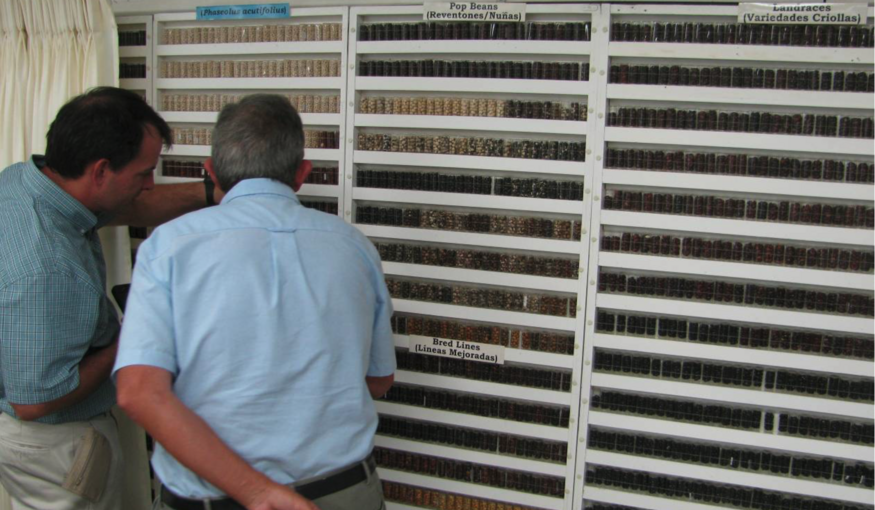This Crazy World

13 April 2012
Luigi Guarino
What you – and they – are looking at is a small fraction of the world’s largest collection of bean diversity. You can admire it, like these guys are doing, at the International Centre for Tropical Agriculture, whose Spanish acronym is CIAT, at its headquarters just outside Cali, Colombia, in the lush, sugarcane-growing valley of the River Cauca. Which is apt, as the Andean ranges which you can see on either side of the valley on clear days are, along with the highlands of Mexico, the ancestral home of the five cultivated New World bean species. A few grains from each of the 36,000 plus varieties in the CIAT genebank, each variety genetically unique, are kept in small glass vials for visitors to marvel at. And marvel they do, as you can see, even when they’ve seen it all before. The people in the photograph are experts, bean breeders. But they behaved like kids in a candy store, and I’m sure they won’t mind me saying that.
Genebanks are sometimes dismissed as “just museums.” Well, there’s certainly something of the museum about this display, though the interest shown by the breeders during my recent visit there would seem not to justify that “just”. But there’s in fact a lot more to running a genebank than putting seeds behind glass and letting people gawp at them. You can’t take the Mona Lisa home. Those breeders can take home bean varieties as unique in their way as any work of art simply by signing a few papers.
But that takes a lot of work. Unsung work. Behind the scenes work. When the beans first come in, you have to check the seeds for diseases, and dry them properly, and package them properly, and document them properly, and store them properly at very low temperature; and check them periodically, grow them out when they show signs of deteriorating, study them so that others will have the information necessary to make decisions about which ones to use in their work, and make them readily available on request. That’s expensive. But you want to do it right. In the past few years we at the Trust have been helping countries as far afield as Myanmar, Uganda and Peru duplicate their unique bean diversity at CIAT for safety, in case anything happens in their own genebanks. These countries trust CIAT to maintain their diversity for them under the best possible conditions. Keeping a few dead seeds in glass vials is fun for visitors but doesn’t amount to a hill of beans. Keeping 36,000 unique natural works of art from all over the world alive and ready for anyone to use in crop improvement and research is going to cost.
How much? The bean counters at CIAT have calculated that to make the collections of beans, cassava and tropical forages entrusted to them available to the world, forever, costs $2.5 million a year. Every year. The Trust is raising an endowment to ensure that CIAT’s collection – and indeed all the other international collections managed by the CGIAR Centres – is well taken care of for the world’s plant breeders in perpetuity. We think about $65 million will do that for the collections maintained at CIAT. To put that into perspective, it’s what the Kardashians made. In a year: it’s apparently their estimated income for 2010.
